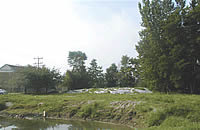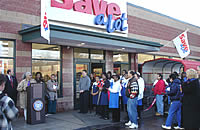Waste Site Cleanup & Reuse in New England
Main & Pavilion Shopping Center - Hartford, CT
(April 2006)
Program: EPA
Revolving Loan Fund
Grantee: Connecticut
Department of Economic and Community Development (contacts)
Summary: Through an RLF loan of $160,000
to a non-profit group, an environmental cleanup consisting of contaminated
soil removal was completed, and a new shopping center was built,
including a much-needed neighborhood grocery store.
The 2.46-acre site at the corner of Main and Pavilion Streets, immediately north of the center of Hartford, had formerly been occupied by residential structures, a dye works, a gas station, a state arsenal, an auto repair facility, and a number of other retail and commercial businesses. In 1994, Glenn Geathers of the Hartford Tenants Rights Federation Inc. began investigating the redevelopment possibilities for the site; he later brought his tenacious involvement with him when he went to work for the Hartford Economic Development Commission. A Phase I Environmental Assessment of the property was carried out in 1998, and because of the past use as a gas station, a dye works, and an auto repair facility, further assessment was recommended. The Phase II Environmental Assessment was carried out in 2000, finding evidence of petroleum contamination in the soil and water.
The EPA awarded a Brownfields Cleanup Revolving Loan Fund (RLF) of $668,000 to the Connecticut Department of Economic and Community Development (CT DECD). From that money, the CT DECD gave a loan of $160,000 to the nonprofit organization “Public Housing Residents Going Places, Inc.” (PHRGP) for their project in the Clay Arsenal neighborhood of Hartford. Those EPA funds went to the removal of contaminated soil.
In 2003 and 2004, eight underground storage tanks were removed, and 2000 tons of contaminated soil was removed from the site for off-site treatment. Post-excavation sampling was clean, so the site was backfilled, and remediation was closed in 2005.
Construction followed, and by the Fall of 2005 the new Main and Pavilion Shopping Center, otherwise known as the “Metro Center”, was finished, with 40,000 square feet of retail space. Also, in addition to construction jobs, the project created 36 new job opportunities for low- to moderate-income persons. A total of $5.2 million in federal, state, local and private funds went to the cleanup and redevelopment of the site.
The Clay Arsenal neighborhood, one of the City's most distressed neighborhoods, is part of Hartford's North End, also now known more positively as Hartford's “Uptown” neighborhood. The 2000 Census suggests that the poverty rate is greater than 50% in the blocks around Main and Pavilion Streets, and 31% overall for Hartford. Only about 30% of the neighborhood residents own cars, and the new shopping center gives them walking access to many basic goods and services that they need. The new Shopping Center is anchored by a Save-a-Lot grocery store and also includes a Family Dollar store, a Laundromat, an American Cellular outlet and clothing and shoe stores.
Timeline:
-
1994: Investigation began into the redevelopment possibilities for the project.
-
June 1998: Phase I Environmental Assessment.
-
March 2000: Phase II Environmental Assessment.
-
July 2003 to March 2004: UST removal and soil removal.
-
April 2005: Remediation close-out.
-
April 2005: CT DECD signed a loan for $160,000 to PHRGP.
-
Fall of 2005: Grand opening of the “Metro Center” shopping center at Main and Pavilion Streets, in the Clay Arsenal neighborhood.
-
Jan 2006: Grand opening of the “Save-A-Lot” grocery store, the largest anchor store in the Metro Center.
Funding:
-
EPA- $160,000 Revolving Loan Fund
- $160,000 Revolving Loan Fund
- City of Hartford
- $100,000 Community Development Block Grant
- Donation of land
- Community Economic Development Fund
- $5,000 Technical Assistance Grant
- $100,000 Bridge Loan Financing
- HUD
- $1,500,000 Section 108 Loan
- $300,000 Brownfield Economic Development Grant
- $300,000 Urban Development Action Grant
- Private
- $2,200,000 Construction
- $500,000 Loan Guarantee




